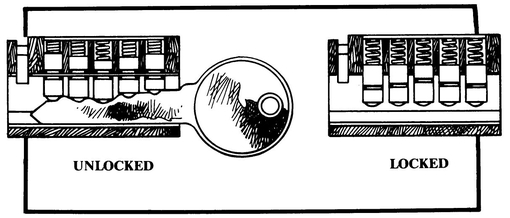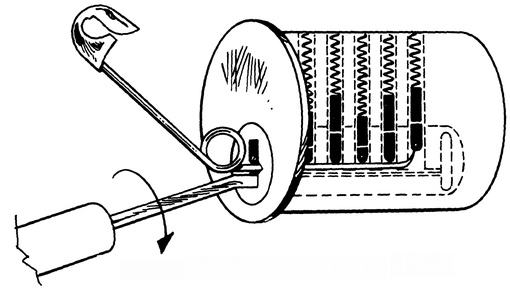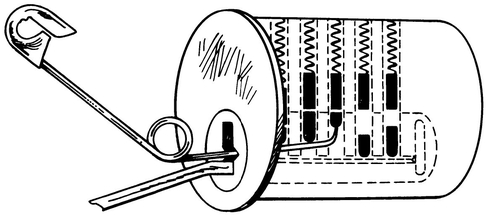Pin Tumbler Locks
Pin tumbler locks offer the most security for their price. They have close machine tolerances and approximately 1,000,000 different key combinations for a five-pin lock. Considering the thousands of different companies making pin tumblers (different shaped keyways for each company or design line), the chances of someone having a key that will work in your front door lock are one in many billions.

Figure 8. A pin tumbler lock.
Pin tumbler locks can easily be identified by peering down the keyway and locating the first round pin. Sometimes you can see the pin’s dividing point, where it breaks with the cylinder wall (shear point).
To successfully pick a pin tumbler lock, your sense of touch sould be honed so that both hands feel the tools. Once the hand holding the pick has located a slight relief in tension while picking a particular tumbler, the other hand holding the tension wrench will feel a relief or breaking point. Both hands should be involved with the sense of touch, the sensing of the inner workings of the lock.
We are now ready to begin the first lesson. First open your front door and check for a pin tumbler lock on it. It should have one on it. If there is one, leave the door open to decrease suspicion. Do not lock yourself out of your apartment or house by being overconfident; not only will you raise suspicion, but window glass is not cheap.
HOW TO PICK A TUMBLER LOCK
STEP ONE
Without using the tension wrench, slip the pick into the lock. The “hook” of the pick should be toward the tumblers (up in most cases, depending on whether or not the lock was mounted upside down—you can tell by looking down the keyway and locating the first pin with your pick). Try to feel the last tumbler of the lock. It should be 7/8 inches into the lock for a five-pin tumbler lock (most common pin tumbler lock used).
Make certain that you have no tension on the wrench when inserting the pick as this will encumber the frontal tumblers. When you feel the back tumbler, slowly raise it with a slight prying motion of the pick. Release it, but keep the pick in the lock on the rear tumbler.
Now insert the tension wrench, allowing room for the pick to manipulate all of the pins. It should be placed at the bottom of the cylinder if the lock was mounted upright, tumblers toward the top of the cylinder. Apply firm and yet gentle clockwise pressure to the tension wrench.

Figure 9. How to pick a tumbler lock, step one.
Slowly raise the back tumbler with a slight prying motion of the pick. A minute click will be felt and heard when it breaks. It will lose its springiness when this occurs, so do not go any further with it. Any further movement with the pick will cause binding by going past the pins’ shear line. Continue an even pressure with the tension wrench.
Keeping an even tension pressure, proceed to Step Two.
STEP TWO
The fourth tumbler should be easily felt since it is the next one in line. Raise it until it breaks, keeping the tension wrench steady. It too will give a sound and sensation when it breaks or aligns.

Figure 10. Step two.
STEP THREE
The third or middle tumbler is next. Again, it too will click. Maintain a constant, even pressure on the wrench—about the same pressure that you would use to replace a cap on a catsup bottle. You may feel the “clicks” in your tension wrench as well as hear them.

Figure 11. Step three.
STEPS FOUR AND FIVE
Continue on to the next tumbler out, working toward you. When it breaks, raise the last (front) tumbler to its braking point and the cylinder should be free to rotate and unlock the door. Sometimes you may have to play with the wrench to open the lock because you may have raised a tumbler too high, past its breaking point. If this is the case, very slowly and gradually release the tension wrench pressure and the overly extended tumbler will drop into its breaking point before the other tumblers have a chance to fall. The cylinder should pop open at that point. I have found that this technique is responsible for over 30 percent of my successes in opening all tumbler locks.
If the lock still refuses to open after all that treatment, release the tension wrench pressure, allowing all of the tumblers to drop and start over. You may have more than one tumbler too high and would be better off to repeat the picking process.

Figure 12. Step four (top), and step five (above).